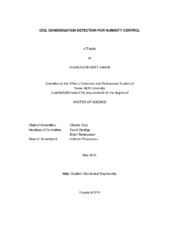| dc.description.abstract | Conditioning the air inside a building requires controlling both primary components of its enthalpy: temperature and humidity. Temperature sensors used in buildings are sufficiently reliable, durable, accurate, and precise that they can be relied on for sophisticated building control systems. Commercial resistive and capacitive humidity sensors become inaccurate near saturation and often fail permanently when exposed to liquid water. Excessive humidity can cause both occupant discomfort and permanent damage to buildings. In American climates dehumidification accounts for the vast majority of the energy used to control humidity. Therefore, a sensor which can survive and accurately measure humidity in hot, wet conditions will allow considerable savings.
Simulations of the energy consumption and savings available from enthalpy economizer control and supply air temperature resets were performed for buildings in Houston, Dallas, and Philadelphia. Temperature economizers were shown to attain between 90% and 95% of the savings of an enthalpy economizer. A spreadsheet simulation of enthalpy economizer use showed that the savings available are heavily dependent on the ability to avoid its use on very hot, humid days.
A newly-designed condensation sensor was developed for this project. It relies on the order-of-magnitude difference in AC reactance between humid air and liquid water. When installed on an AHU, it detects water condensing off the cooling coil as the temperature of the air drops below the dew point. Electronics were designed to provide the 0.25 V, 131 kHz current required and to obtain a 0 V output when dry and a 5 V output when wet.
A field reliability test was successfully performed with the sensor passively monitoring the transitions from wet to dry at Langford Building A and the Jack E. Brown Building at Texas A&M University, College Station, TX. The sensor was shown to be able to provide the reliable state change detection needed to control an economizer. The main limitation of this sensor is slow response on dry-to-wet and wet-to-dry transitions. Most measured dry-to-wet response times were between 5 and 10 minutes, which were driven by the time required to saturate the cooling coil. | en |


